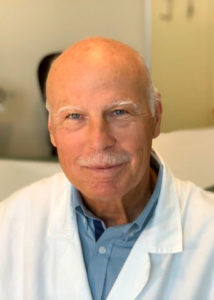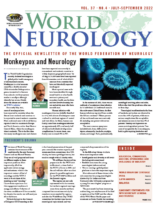
Wolfgang Grisold
This issue of World Neurology contains the statements of the candidates for the new Secretary General and one Elected Trustee. They are all well prepared and focus on different angles to these important positions. Most importantly, all of the applicants radiate energy and enthusiasm, which is the important content of fuel of neurology and the WFN. I want to thank them all for standing up and “running.” I know from experience that this engagement needs much energy and efforts. Only two of the seven candidates will be successful, but despite the results, we will need you all in the future.
We look forward to the Council of Delegates (COD) meeting as this is the formal presentation of the past year, contains the trustees reports, and statements from committees. As a U.K. charity, we have a privileged status, but need to comply with all charity rules.
We will hear the state of the preparation for the WCN 2023 in Montreal, a closer look at the WCN in Korea in 2025, and the call will also allow us a first glance for possible applicants for the WCN 2027 in Africa and the Panarab region.
The regions are not only represented with the trustees, but we have regional meetings every three months and have composed the committees strictly by members recommended by regions, and also the World Brain Day (WBD) committee for the first time was not neurological topic related, and was composed of representatives of the regions.
In the following visions, we have three more important tasks:
- Install gender and diversity at all levels (including subcommittees)
- Establish structures for young neurologists (subcommittee)
- We are creating a global patient platform to have this important input.
Most advanced of these visions is the subcommittee for young neurologists (chaired by Dr. Lehmann from Germany), who will make a proposal for a young first neurologists’ program at WCN 2023.
The past month has been interesting and exciting, not only because of the final acceptance of the IGAP, and the release of the WHO Brain Health paper and statement on Brain Health, but resulting from this, an enormous momentum for neurology worldwide. These plans define the importance of the IGAP in politics, treatment, prevention, innovation and research, and public health. All the WHO member states (all have agreed) to implement the concepts in their health systems within 10 years. Due to circumstances, income, regions, and per health capita, this is not a linear task, but it has been put out and is now ready to be implemented. The WFN is aligning with the WHO and other non-state actors and NGOs to implement and advocate, and it will be an important task to implement and progressively develop. The momentum could not be bigger, and the time is now.
We have had a successful WBD, themed “Brain Health for All,” which was a good and useful alignment with IGAP and Brain Health. We are glad that so many countries took this up, and please look also at our website for more reports.
The WHO is not the only international body for the WFN; also the target to be part of Economic and Social Council (ECOSOC) (UN) was reached, and the WFN will be allowed to attend the ECOSOC meetings at the UN and will have a stronger voice internationally. The ECOSOC has issued the Sustainable Development Goals (SDGs) as a call for action by all countries—developed and developing—in a global partnership to end poverty and other deprivations and improve health and education among other goals.
Education is the backbone of the WFN, and reaches from congresses, individual support, grants toward Department Visits and Teaching Centers, and as a successful new implantation the WFN has created the Educational Days.
Publications, CME: The issue of CME is important, and needs to be free from industrial influence. See “Education, Congresses, and CME: Sponsoring and Influence of Industry” by Wolfgang Grisold and Steven Lewis on this page.
The WFN Teaching Centers are well under way and it is now planned to add a four-year training post in Rabat and a one-year stroke fellowship in Cape Town.
Since the implementation of the Teaching Centers in Rabat in 2013 and the subsequent Teaching Centers and the Department Visits, these have become successful educational tools. For the last two calls for Department Visits, we had as many as 18 applicants for one country.
With regard to the WFN Department Visit development, we are glad to have Spain host a Department Visit from Latin America, and India will invite a Department Visit from Asia in the near future.
The model of the WFN educational days has proved a successful concept. After sessions devoted to stroke and epilepsy, this year the topic was “Movement Disorders” and took place Sept. 3, in a joint activity with AFAN and the MDS and also endorsed by the AAN and the EAN.
The EAN is holding its regional teaching course (RTC) in Douala, Cameroon, this year, and the WFN will continue to support RTCs.
Our WFN Specialty Group on Neuromuscular Disease had a successful ICNMD 2023 Congress in Brussels with 1,400 participants. The next ICNMD meeting will be in Perth in 2024, and the call for 2026 is presently out.
We are happy to say that the Journal of the Neurological Sciences, the official journal of the WFN, has reached a new, higher Impact Factor, and is also renovating the editorial board. The eNS is flourishing under Walter Struhal’s leadership, and still has a way to go in the rankings.
Our most frequented media are World Neurology (Steven Lewis) and social media, which have ever-expanding readerships, and the social media that started a long time ago is now gaining momentum, with approximately 14,000 followers on Facebook, 7,000 on Twitter, and 4,000 on LinkedIn.
Special thanks go to Steven Lewis, Kimberly Karlshoej, Chiu Keung Man, and Walter Struhal, who are enthusiastically working on these information loops. •
